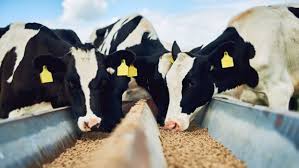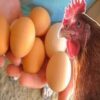Biotechnology applies biological knowledge to enhance and improve the environment, health, and food supply. Through biotechnology, scientists aim to develop environmentally friendly alternatives to fossil fuels and plastics, new medicines, vaccines, disease diagnostic tools, and higher-yielding, more nutrient-rich crop plants.
Biotechnology has applications in four major industrial areas: healthcare (medical), crop production and agriculture, non-food (industrial) uses of crops and other products (e.g., biodegradable plastics, vegetable oil, biofuels), and environmental uses.
Read Also: Sheep gene insights could help farmers breed healthier animals
1. Application of Biotechnology in Animal and Feed Production and Nutrition
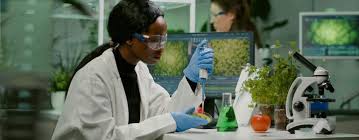
Animal nutrition is crucial in any animal husbandry production system. Feed represents the largest single cost item in livestock and poultry production, accounting for 60%–70% of the total cost in most years. Several research interventions are underway to reduce feeding costs by utilizing unconventional feed or applying biotechnology tools to enhance the nutritional availability and digestibility of animal feed.
Biotechnology in animal nutrition mainly utilizes recombinant DNA technology and fermentation technologies. These techniques often rely on microorganisms for producing nutrients like essential amino acids, complete proteins, or improving the digestibility of animal feeds.
Biotechnology is used to increase the quality of silage, produce probiotics, create specific enzymes and hormones (e.g., somatotropin, phytase), degrade fiber content in feed and fodder, and alter ruminal flora.
Additionally, biotechnology can increase animal productivity through better nutrition, production potential, and improved health conditions. Nutrients like protein, amino acids, and fats can be produced or protected based on the needs of animals in different physiological states.
Enzymes are utilized to improve nutrient availability and reduce feed wastage. Prebiotics, probiotics, or immune supplements can help inhibit enteric pathogenic bacteria. Plant biotechnology can be employed to produce feed and fodder with better nutritional values.
Vaccines or antibodies can be added to feeds to protect animals from disease. Genetic manipulation of rumen microbes can improve animal health. However, acceptance of biotechnology in animal nutrition is influenced by social, cultural, and economic factors. Various ways to improve feed production, nutrition, and animal production include:
a. Protection of Protein, Amino Acids, and Fats: The rumen degrades proteins into ammonia, and ruminal microbes use non-protein nitrogen to synthesize microbial protein. To improve protein utilization, it must be protected from ruminal degradation through chemical treatments like formaldehyde or physical treatments such as heat treatment and extrusion cooking.
For example, formaldehyde treatment of groundnut cake can reduce protein degradability by 33%. Fats can be protected through saponification with calcium salts, which increases dietary energy density for animals in negative energy balance.
b. Use of Enzymes: Enzymes are increasingly used to enhance feed utilization and reduce methane production, thereby lowering carbon footprints. Most enzymes are cocktails of various enzymes, such as pentosanase, pectinase, a-galactosidase, and phytase, which are derived from bacteria or fungi.
Enzymes help remove antinutritional factors in feed, such as glucans and arabino-xylans in barley grain, improve digestibility of nutrients like phytate phosphorus, and break down non-starch polysaccharides in plants. Research has shown that supplementing diets with enzymes like cellulose and hemicelluloses improves weight gain and feed efficiency.
c. Prebiotics and Probiotics: Prebiotics, such as oligosaccharides (e.g., fructo-, gluco-, and galacto-oligosaccharides), resist digestion by animal enzymes and promote the growth of beneficial microbes. Probiotics are live microbial feed supplements that beneficially affect the host by improving intestinal microbial balance. Lactic acid-producing bacteria are the most common probiotics used in animal feed.
d. Addition of Vaccines or Antibodies in Feeds: Many modern feeds and fodder come from genetically modified plants with improved disease and pest resistance, and their nutritional value remains unaffected. Plants can also be used as bioreactors to produce recombinant biopharmaceuticals, such as cytokines, hormones, monoclonal antibodies, bulk enzymes, and vaccines.
e. Metabolic Modifiers: Metabolic modifiers, such as recombinant bovine somatotropin (rBST), are used to improve production efficiency (e.g., weight gain, milk yield) and carcass composition (e.g., meat-fat ratio). In developed countries, rBST increases milk yield by 10-15%. Similarly, porcine somatotropin promotes muscle growth and reduces body-fat deposition, resulting in leaner pigs with greater market value.
f. Genetic Manipulation of Microbes: Genetic manipulation of rumen microbes can enhance their cellulolytic ability, reduce methanogenesis, and improve overall feed utilization. This manipulation also helps eliminate antinutritional factors and promotes the synthesis of essential amino acids by rumen microbes. Research is also focused on introducing lignin breakdown properties into ruminal microbes using enzymes like lignase produced by soft-rot fungi.
g. Use of Hormones: For example, Porcine Growth Hormone (PSt) is used in controlled amounts to enhance growth rate, improve feed efficiency, and reduce fat deposition in pigs. However, the use of PSt in developing countries may be limited due to high costs and small-scale farming practices.
2. Application of Biotechnology in Animal Reproduction
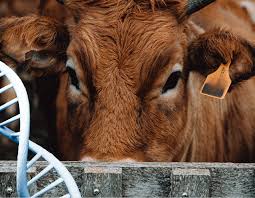
Biotechnology plays a significant role in breed improvement, reproductive rates, and overall animal production. The most common reproductive applications integrated with biotechnology include artificial insemination (AI), semen preservation, sperm sexing, synchronization, fixed-time insemination, superovulation, embryo transfer (ET), and in vitro embryo production (IVEP).
a. Artificial Insemination (AI):
AI has been practiced on domestic animals for hundreds of years and is one of the earliest reproductive biotechnologies. It allows the use of superior males for breeding purposes. This technique involves semen collection from superior males, its dilution, freezing, and deposition in the female reproductive tract.
b. Advantages of Artificial Insemination:
i. Increases the use of superior male animals, improving genetic quality and efficiency in breeding.
ii. Increases milk production by up to 30% in dairy herds compared to natural breeding.
iii. Enhances genetic improvement of farm animals and helps control venereal diseases (e.g., trichomoniasis, vibriosis, brucellosis).
iv. Reduces the need for keeping inferior bulls and their associated costs.
v. Makes semen transportation easier and more economical than transporting male animals.
vi Allows for semen use even after the death of a male.
c. Disadvantages of Artificial Insemination:
i. Requires well-trained personnel to handle semen collection, examination, freezing, shipping, and insemination.
ii. Increased use of AI could lead to the transmission of genetic abnormalities, such as COD or spastic syndrome.
iii. A limited number of elite bulls are used, which may increase the risk of inbreeding and genetic issues.
d. Sex Sorted Semen: The sex of a fetus is determined by the sperm, which may carry either an X or Y sex chromosome. AI allows for sex sorting of sperm, with the X chromosome producing female offspring and the Y chromosome producing male offspring. In the dairy industry, female calves are more desirable for milk production, making sex-sorted semen highly beneficial for maximizing milk production.
3. Controlled Breeding and Estrus Synchronization
Early detection of estrus is a major challenge due to the increasing number of cows being reared, advancements in high-yield dairy breeds, and changes in feeding and management systems. Estrus synchronization, or controlled breeding, is a method used to group females for parturition at the same time.
This technique is widely employed in commercial dairy farms to ensure uniform milk production throughout the year. It is closely linked with artificial insemination (AI) and serves as a prerequisite for embryo transfer. Estrus detection can be time-consuming, but synchronization significantly reduces the time required for detection, enabling timed insemination.
4. Multiple Ovulation and Embryo Transfer (MOET)
MOET enhances genetic improvement by increasing the number of offspring from monotocous species. In cattle, this technology is widely used to reduce generation intervals compared to traditional progeny-testing schemes.
Sires can be selected based on the performance of their MOET-produced full sisters rather than their female progeny. This method, known as the MOET nucleus scheme, has the potential to accelerate genetic progress, particularly in developing countries where large-scale AI-based progeny testing is difficult to implement.
5. Nuclear Transfer or Embryo Cloning
The transfer of totipotent nuclei into enucleated oocytes enables the production of genetically identical clones. Initially, blastomeric nuclei were used, but the efficiency of cloning has remained limited. Recent advances, such as the generation of totipotent embryonic stem (ES)-like cells in sheep, may improve the efficiency of embryo cloning in the future.
6. In Vitro Fertilization (IVF)
IVF involves collecting oocytes from donor females, maturing them in a laboratory, and fertilizing them in a controlled environment. The resulting embryos are cultured and transferred to recipient females.
Eggs are incubated in CO2 incubators, and viable sperm are processed for insemination. Due to the zona pellucida and follicular cells surrounding the ova, approximately 100,000 spermatozoa per egg are used to ensure fertilization. IVF is particularly useful in addressing infertility issues such as blocked fallopian tubes.
Read Also: Sheep gene insights could help farmers breed healthier animals
7. Application of Biotechnology in Genetics and Breeding
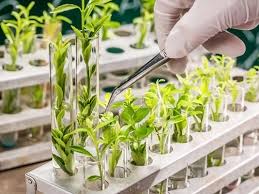
Animal breeding benefits from various biotechnologies that enhance genetic progress. Technologies such as AI, multiple ovulation, IVF, embryo transfer, sexing of semen, and cloning improve germplasm distribution and selection accuracy. However, these techniques may also reduce genetic variance.
Advances in genetic marker detection, including quantitative trait loci (QTL) identification, further improve breeding efficiency by enabling early and accurate selection. Gene editing holds future potential but requires further research to optimize its impact.
8. Application of Biotechnology in Disease and Metabolic Control
Biotechnology plays a vital role in disease and metabolic control. Genomics provides insights into gene functions, enzyme behaviors, and metabolic pathways, aiding in disease prediction and treatment.
Metabolic control analysis (MCA) quantitatively assesses biochemical networks and helps identify therapeutic targets for diseases like diabetes and cancer. Understanding metabolic regulation enhances drug discovery and treatment strategies.
9. Application of Biotechnology in Pollution Abatement and Environmental Management
Environmental biotechnology addresses pollution and ecosystem management through several key applications:
- 1. Biomarkers: Indicators of chemical exposure or pollution effects, useful in tracking oil sources and contamination levels.
- 2. Bioenergy: Utilizes biogas, biomass, biofuels, and hydrogen as renewable energy sources, reducing environmental pollution.
- 3. Bioremediation: Uses natural microorganisms to convert hazardous substances into non-toxic compounds.
- 4. Biotransformation: Converts complex compounds into simpler, non-toxic forms for safer industrial processes.
10. Benefits of Environmental Biotechnology
- 1. Maintains a clean and sustainable environment for future generations.
- 2. Reduces hazardous pollutants and waste.
- 3. Encourages sustainable development while protecting natural resources.
- 4. Contributes to pollution control by converting waste into reusable products.
- 5. Advances in genomics, proteomics, and bioinformatics enhance environmental protection efforts.
Biotechnology continues to revolutionize breeding, disease management, and environmental sustainability, offering innovative solutions for the agricultural and livestock industries.
Do you have any questions, suggestions, or contributions? If so, please feel free to use the comment box below to share your thoughts. We also encourage you to kindly share this information with others who might benefit from it. Since we can’t reach everyone at once, we truly appreciate your help in spreading the word. Thank you so much for your support and for sharing!

